Conwy, Wales, UK 作者: 来源: 发布时间:2021-09-17
I. Population and Area
Continent: Europe
Country: The U.K
State/Province: Wales
City/Town: Conwy
Total Area: 435 (sq mi)
Population in 2011: 14.72 (thousand)
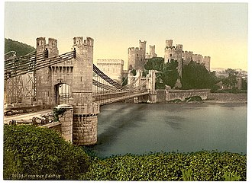
Reference Website:
https://www.britannica.com/place/Conwy-county-borough-Wales
II. Natural Geography (environment and resources)
Geography
Containing the major settlements of Llandudno, Llandudno Junction, Llanrwst, Betws-y-Coed, Conwy, Colwyn Bay, Abergele, Penmaenmawr and Llanfairfechan, it has a total population of 115,000 (2011 census) and borders the counties of Gwynedd and Denbighshire. The River Conwy, after which the county borough is named, lies wholly within the area: rising in Snowdonia and flowing through Llanrwst and Trefriw en route to the Irish Sea by Conwy. The river here marks the border between the historic counties of Caernarfonshire and Denbighshire.
One third of the land area of the county borough lies in the Snowdonia national park, and the council appoint three of the 18 members of the Snowdonia National Park Authority. Its total area is 1,130 square km, making it slightly larger than Hong Kong. The eastern part includes the larger section of Mynydd Hiraethog. The vast majority of the population live on the coast; the only settlement of any size inland is Llanrwst.
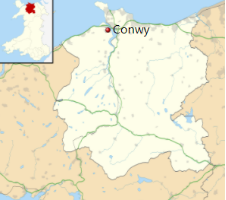
Railway bridge
The Conwy Railway Bridge, a Tubular bridge, was built for the Chester and Holyhead Railway by Robert Stephenson. The first tube was completed in 1848, the second in 1849. The bridge is still in use on the North Wales Coast Line, along with the station, which is located within the town walls. In addition to a modern bridge serving the town, the A55 road passes under the river by a tunnel, Britain's first immersed tube tunnel, which was built between 1986 and 1991. The old mountain road to Dwygyfylchi and Penmaenmawr runs through the Sychnant Pass, at the foot of Conwy Mountain.
Suspension bridge
Conwy has other tourist attractions that help draw visitors to the town. Conwy Suspension Bridge, designed by Thomas Telford to replace the ferry, was completed in 1826 and spans the River Conwy next to the castle. Telford designed the bridge's supporting towers to match the castle's turrets. The bridge is now open to pedestrians only and, together with the toll-keeper's house, is in the care of the National Trust.
III. Economy
According to Eurostat figures there are huge regional disparities in the UK with GDP per capita ranging from €15,000 in West Wales to €179,800 in Inner-London West. There are 26 areas in the UK where the GDP per person is under €20,000.
These areas are the following:
· 4.5 million (8.5% of English) live in these deprived English districts. 11 of these deprived regions in England: Durham, Northumberland, Greater Manchester North, Blackpool, Sefton, Wirral, Barnsley Doncaster Rotherham, South Nottinghamshire, Dudley, Outer London – East North East, Torbay
· 1.4 million (45% of Welsh) live in these deprived Welsh districts. 6 of these deprived regions in Wales: Isle of Anglesey, Conwy & Denbighshire, South West Wales, Central Valleys, Gwent Valley, Powys
· 1.1 million (20% of Scottish) live in these deprived Scottish districts. 5 of these deprived regions in Scotland: Clackmannshire & Fife, East & Mid Lothian, East & West Dumbartonshire, East & North Ayrshire, Caithness Sutherland & Ross,
· 1.1 million (60% of Northern Irish) live in these deprived Northern Irish districts.3 of these in Northern Ireland: Outer Belfast, North of Northern Ireland, West & South of Northern Ireland.
Comparison with Ireland
In Wales, GDP per capita varies from €15,100 in Isle of Anglesey to €30,400 in Cardiff.
When compared to the Republic Of Ireland, GDP per capita ranges from €16,980 in the Irish Midlands to €57,200 in Dublin.
Regions (NUTS3) | GDP € (2013) | GDP per capita € (2013) | GDP € (2016) | GDP per capita € (2016) |
Isle of Anglesey | € 1.167 bn | €16,700 | € 1.305 bn | €18,600 |
Gwynedd | € 2.956 bn | €24,200 | € 3.224 bn | €26,000 |
Conwy & Denbighshire | € 4.246 bn | €20,200 | € 4.767 bn | €22,600 |
South West Wales | € 7.678 bn | €20,000 | € 8.723 bn | €22,700 |
Central Valleys | € 5.939 bn | €20,100 | € 6.812 bn | €22,900 |
Gwent Valleys | € 5.962 bn | €17,500 | € 6.923 bn | €20,200 |
Bridgend & Neath Port Talbot | € 6.016 bn | €21,500 | € 7.240 bn | €25,400 |
Swansea | € 5.532 bn | €23,100 | € 6.332 bn | €25,800 |
Monmouthshire & Newport | € 6.322 bn | €26,500 | € 7.260 bn | €30,000 |
| Cardiff & Vale of Glamorgan | € 14.361 bn | €30,000 | € 16.590 bn | €33,900 |
Flintshire & Wrexham | € 8.346 bn | €28,800 | € 9.374 bn | €32,200 |
Powys | € 2.869 bn | €21,600 | € 3.134 bn | €23,700 |
TOTAL | € 71.396 bn | €23,200 | €81.683 bn | €26,200 |
IV. Industrial Characterisitics
Major industries:
Industry isn’t something that’s confined to the great Industrial Revolution that transformed Britain in the 18th and 19th centuries. We were busy making things long before that.
In the hills above Penmaenmawr you’ll find one of the most important prehistoric landscapes in Britain. A stone and bronze age ceremonial patchwork of stone circles, standing stones and tombs. Right at the top of Graiglwyd mount are numerous sources for stone-axe-making which turned out axes by the cartload. They must have had a full order book, for Penmaenmawr axes have been found all over Britain.
Can you imagine what it must have been like when miners used just stone and bone tools to dig underground? Marvel at their achievements – and fear for the conditions.
Major projects and related introductions:
Discovery Orion-style
Another Orion variant. This one is closely based on an original concept art drawing for 2001 : A Space Odyssey. View the gallery here and the animation here. A detailed article is available on my blog. I'm rather proud of this one, it came out exactly the way I intended.
The Invasion of Cardiff
After seeing Steven Spielberg's rare but extreme foolishness, I was inspired to create my own version of the War of the Worlds. Set in modern-day Cardiff with Jeff-Wayne inspired tripods, handling and flying machines, and lots and lots of explosions. Not an animation but a QuickTime panorama – view the destruction of inner-city Cardiff as if you were there ! Download it or view it online here, and don't forget the image gallery here.
Reference Website:
http://www.rhysy.net/major-projects-1.html
https://www.visitconwy.org.uk/explore/heritage/industrial-heritage
V. Attractions
1. Conwy Castle and Walls:
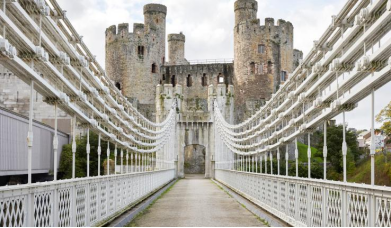
Climb to the top of one of Conwy Castle's eight towers to get a stunning view over Conwy and the surrounding area. Investigate the inner and outer wards with their many rooms and explore the castle walls with their 21 towers that completely enclose Conwy town.
2. Smallest house in Britain:
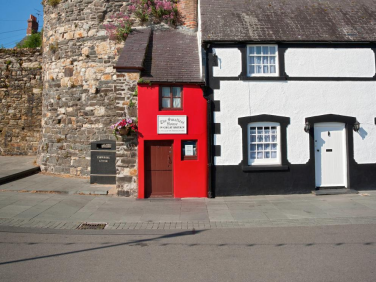
Known as the Quay House, this red painted one up one down measures only 3.05m x 1.83m (10 x 6ft) and was last lived in by Robert Jones who was 1.905m (6ft 3 inches) tall. Squeeze in and see what it would be like to live in Britain’s smallest house.
3. Bodnant Garden:
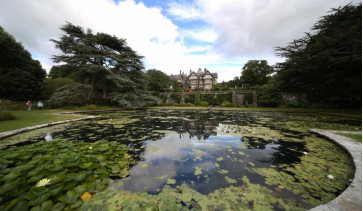
Bodnant Garden is one of Wales’ best gardens and a great place to relax and unwind. There are expansive lawns, intimate corners, grand ponds and impressive terraces, plus a steep wooded valley and stream to explore. The remarkable plant collections from all over the world are showcased in finest style.
Reference Website:
https://www.visitwales.com/en-us/destinations/north-wales/10-brilliant-places-visit-conwy
VI. History
Castle and town walls
Conwy Castle and the town walls were built, on the instruction of Edward I of England, between 1283 and 1289, as part of his conquest of the principality of Wales. The church standing in Conwy has been marked as the oldest building in Conwy and has stood in the walls of Conwy since the 14th century. However, the oldest structure is part of the town walls, at the southern end of the east side. Here one wall and the tower of a Llys belonging to Llywelyn the Great and his grandson Llywelyn ap Gruffydd have been incorporated into the wall. Built on a rocky outcrop, with an apsidal tower, it is a classic, native, Welsh build and stands out from the rest of the town walls, due to the presence of four window openings. It dates from the early 13th century and is the most complete remnant of any of his Llys. People born within the town walls of Conwy in north Wales are nicknamed "Jackdaws", after the jackdaws which live on the walls there. A Jackdaw Society existed until 2011. The population of the town in 1841 was 1,358.
Abbey
Conwy was the original site of Aberconwy Abbey, founded by Llywelyn the Great. Edward and his troops took over the abbey site and moved the monks down the Conwy valley to a new site at Maenan, establishing Maenan Abbey. The parish church still retains some parts of the original abbey church in the east and west walls. English settlers were given incentives to move to the walled garrison town, which for decades the Welsh were forbidden from entering.
Suspension bridge
Conwy has other tourist attractions that help draw visitors to the town. Conwy Suspension Bridge, designed by Thomas Telford to replace the ferry, was completed in 1826 and spans the River Conwy next to the castle. Telford designed the bridge's supporting towers to match the castle's turrets. The bridge is now open to pedestrians only and, together with the toll-keeper's house, is in the care of the National Trust.
Railway bridge
The Conwy Railway Bridge, a Tubular bridge, was built for the Chester and Holyhead Railway by Robert Stephenson. The first tube was completed in 1848, the second in 1849. The bridge is still in use on the North Wales Coast Line, along with the station, which is located within the town walls. In addition to a modern bridge serving the town, the A55 road passes under the river by a tunnel, Britain's first immersed tube tunnel, which was built between 1986 and 1991. The old mountain road to Dwygyfylchi and Penmaenmawr runs through the Sychnant Pass, at the foot of Conwy Mountain.
Aberconwy House
The National Trust owns Aberconwy House, which is Conwy's only surviving 14th-century merchant's house, one of the first buildings built inside the walls of Conwy.
Plas Mawr
Plas Mawr is an Elizabethan house built in 1576 by the Wynn family, which has been extensively refurbished to its 16th-century appearance and is now in the care of Cadw and open to the public.
Smallest house in Great Britain
The house named in the Guinness Book of Records as the Smallest House in Great Britain, with dimensions of 3.05 metres x 1.8 metres, can be found on the quay. It was in continuous occupation from the 16th century (and was even inhabited by a family at one point) until 1900 when the owner (a 6-foot (1.8 m) fisherman – Robert Jones) was forced to move out on the grounds of hygiene. The rooms were too small for him to stand up in fully. The house is still owned by his descendants today, and visitors can look around it for a small charge.
VII. Culture
Conwy County Borough Council was granted a coat of arms by the College of Arms in 2001. The new arms recall those of both Aberconwy and Colwyn Borough Councils. The main part of the shield depicts blue and silver waves for the river from which the county borough takes its name, and also recalls the gold and blue wavy field of Colwyn's arms. On top of the waves is placed a symbolic red tower, representing Conwy Castle. The chief or upper third of the shield is coloured green, the main colour in Aberconwy's arms. In the centre of the chief is a severed head from the heraldry of Marchudd ap Cynan, Lord of Abergele and Rhos. On either side are two black spears embrued, or having drops of blood on their points. These come from the reputed arms of Nefydd Hardd, associated with the Nant Conwy area. In front of each spear is a golden garb or wheatsheaf, for the rural areas of the county borough.
Above the shield, placed on the steel helm usual to British civic arms, is the crest. This takes the form of the Welsh red dragon supporting a Bible, rising from a wreath of oak leaves and acorns. The representation of the Bible is to commemorate the fact that the first Welsh language translation of the book originated in the area, while the oak circlet recalls that an oak tree formed the main charge in the arms of Colwyn Borough Council, and its predecessor the municipal borough of Colwyn Bay.
The motto adopted is "Tegwch i Bawb", meaning "Fairness to All".
VIII. Other information
Conwy Castle is a fortification in Conwy, located in North Wales. It was built by Edward I, during his conquest of Wales, between 1283 and 1289. Constructed as part of a wider project to create the walled town of Conwy, the combined defences cost around £15,000, a huge sum for the period. Over the next few centuries, the castle played an important part in several wars. It withstood the siege of Madog ap Llywelyn in the winter of 1294–95, acted as a temporary haven for Richard II in 1399 and was held for several months by forces loyal to Owain Glyndŵr in 1401.
Following the outbreak of the English Civil War in 1642, the castle was held by forces loyal to Charles I, holding out until 1646 when it surrendered to the Parliamentary armies. In the aftermath, the castle was partially slighted by Parliament to prevent it being used in any further revolt, and was finally completely ruined in 1665 when its remaining iron and lead was stripped and sold off. Conwy Castle became an attractive destination for painters in the late 18th and early 19th centuries. Visitor numbers grew and initial restoration work was carried out in the second half of the 19th century. In the 21st century, the ruined castle is managed by Cadw as a tourist attraction.
UNESCO considers Conwy to be one of "the finest examples of late 13th century and early 14th century military architecture in Europe", and it is classed as a World Heritage site. The rectangular castle is built from local and imported stone and occupies a coastal ridge, originally overlooking an important crossing point over the River Conwy. Divided into an Inner and an Outer Ward, it is defended by eight large towers and two barbicans, with a postern gate leading down to the river, allowing the castle to be resupplied from the sea. It retains the earliest surviving stone machicolations in Britain and what historian Jeremy Ashbee has described as the "best preserved suite of medieval private royal chambers in England and Wales" In keeping with other Edwardian castles in North Wales, the architecture of Conwy has close links to that found in the Kingdom of Savoy during the same period, an influence probably derived from the Savoy origins of the main architect, James of Saint George.
IX. Contact information
Mayor/Officer: Emma Leighton-Jones
Tel: (01492) 596254
Mail: info@conwytowncouncil.gov.uk
Reference Website:
https://www.conwytowncouncil.gov.uk/en/the-council/the-mayor
